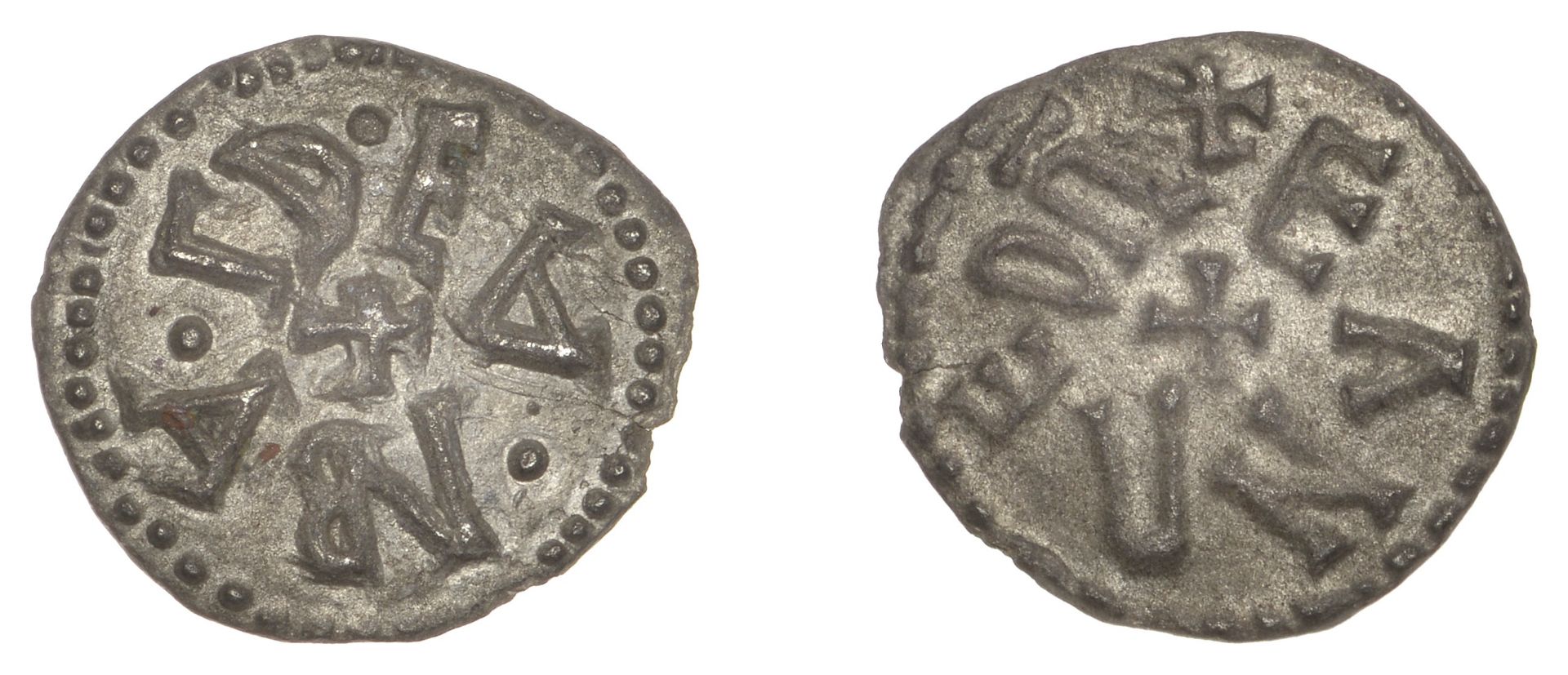Archbishops of York, Abp Eanbald II (796-835) under Eanred (810-41), Sceatta or Penny, late 820s, · ea · nba · ld around small cross pattée, reading outwards, rev. +eanred r around small cross pattée, 0.91g/12h (SCBI Abramson –; Abramson –; Parsons –; Pirie –; N –; S –). Good very fine, struck on a broad flan; unlisted in the standard references and seemingly UNIQUE £600-£800 --- Provenance: Found near Driffield, E. Yorkshire (EMC 2021.0352). This coin represents the first known example of a Sceatta or Penny struck jointly under the authority of King Eanred and Archbishop Eanbald II. There was strong tradition of joint regal and archiepiscopal coins minted in the Kingdom of Northumberland, beginning under King Eadberht (737-58) and his brother Ecgberht, the Archbishop of York. The production of these joint issues continued regularly up until the pontificate of Eanbald II, at which point they were abandoned. This remarkable coin reveals that the minting of joint regal and archiepiscopal coins was revived, for a brief time, towards the end of Eanbald’s tenure as archbishop. The coinage of king Eanred (810-40) has been reviewed most recently by Stewart Lyon in the introduction to SCBI 68. Lyon divided Eanred’s coinage into two phases, distinguished from one another largely on the grounds of fabric. This coin is evidently struck from relatively good silver and thus consistent with the first phase of Eanred’s coinage. The style of the letter forms on the reverse conform closely to those seen on Eanred’s Phase I pennies signed by the moneyer Cuthheard (SCBI 68, 66). This moneyer appears to have had a preference for tall slender letters, particularly noticeable on the letter r, where the tail is almost parallel to the left limb. Another feature of Cuthheard’s work is the use of a cross as the principle obverse type, appearing directly below, and aligned, with the initial cross of the legend. The obverse of this coin carries the name Eanbald in the legend, with the letters inverted and reading outwards. Two men with the name Eanbald held the position of Archbishop successively during the late eighth and early ninth centuries, with Eanbald II replacing his namesake in 796. His pontificate appears to have lasted into the 830s. From a chronological perspective the latter Eanbald makes a better candidate to be the authority named alongside Eanred. Confirmation of this is provided by a die link between this coin and three regular archiepiscopal pennies, all signed by the moneyer Æthelweard (EMC 1997.0430, CNG eAuction 492, lot 1019, CNG 111, lot 1057). Æthelweard signed dies under both Eanbald II and his successor Wigmund. He was the only man whose employment continued following the start of Wigmund’s pontificate and Lyon intelligibly suggests that Æthelweard was the latest of Eanbald II’s moneyers. On this basis, a date for the minting of this unique joint issue Penny in the late 820s seems plausible. Given the dating indicated by the numismatic evidence it is tempting to associate this unique and important coin with the events surrounding the treaty at Dore. In 829 Ecgberht, king of Wessex, succeeded in finally conquering the Kingdom of Mercia. This extended the border of Ecgberht’s dominion to Northumbira, which provided the next logical target for further conquest. Acknowledging the threat posed Eanred submitted to Ecgberht and recognised him as overlord, no doubt with the intention of preventing war. In the end the treaty at Dore was superfluous. The following year the defeated Mercian king, Wiglaf, rose up and ‘obtained the Mercian Kingdom again’, driving Ecgberht back to the south of England. This joint regal and archiepiscopal penny evidently belongs to a special and short-lived issue minted around the time of these events. Perhaps it reflects an attempt to demonstrate political unity between crown and church in the face of Ecgberht’s impending invasion. Alternatively, it could represent a celebratory issue, minted following the removal of Wessex forces from the Northumbrian border. In either case it hints at a period of close, but short lived, co-operation between king and archbishop
Auctioneer's Buyers Premium: 24% (+VAT)
There is an additional charge of 4.95% (+VAT/sales tax)
See Full Terms And Conditions



